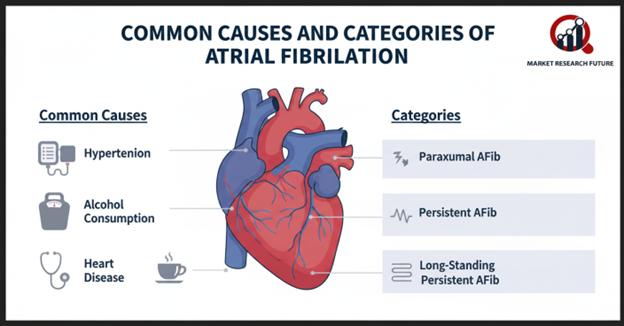Common Causes and Categories of Atrial Fibrillation

Atrial fibrillation Market Overview
Atrial fibrillation (AFib) is the most common cardiac arrhythmia globally, characterized by an irregular and often rapid heartbeat that can lead to severe complications such as stroke, heart failure, and other cardiovascular disorders. It occurs when the atria (upper chambers of the heart) beat chaotically and out of sync with the ventricles (lower chambers), disrupting normal blood flow.
As lifestyle diseases, aging populations, and stress-related cardiovascular conditions rise globally, AFib has emerged as a major public health concern. The growing emphasis on early diagnosis, preventive cardiology, and patient-centered care is reshaping how healthcare systems manage AFib. With advancements in diagnostics, wearables, and AI-enabled monitoring, patients today are more empowered than ever to take control of their heart health.
According to the Centers for Disease Control and Prevention (CDC), atrial fibrillation affects about 0.5% of the global population, with prevalence increasing significantly with age—nearly 2% of individuals under 65 and up to 9% of those over 65 experience AFib.
What is Atrial Fibrillation?
Atrial fibrillation is a rhythm disorder in which the heart’s upper chambers beat irregularly, causing inefficient blood flow to the ventricles. This irregular rhythm can lead to blood clots, stroke, and heart failure if left untreated.
AFib is not always continuous and can vary in duration and severity, ranging from brief episodes to permanent irregularities. While it can occur in individuals without underlying heart disease, it is often associated with structural heart abnormalities or systemic conditions.
Categories of Atrial Fibrillation
Atrial fibrillation is clinically classified into four main categories based on duration and persistence:
- Occasional (Paroxysmal AFib)
- Symptoms come and go, lasting from minutes to hours, sometimes up to a week.
- Heart rhythm often returns to normal without intervention, though episodes may repeat.
- Treatment may depend on the frequency and severity of symptoms.
- Persistent AFib
- The irregular heartbeat lasts longer than occasional AFib and does not resolve on its own.
- Medical intervention, such as electrical cardioversion or medication, is required to restore normal rhythm.
- Long-Standing Persistent AFib
- Continuous atrial fibrillation lasting more than one year.
- Requires advanced medical management and often long-term rhythm or rate control strategies.
- Permanent AFib
- The heart’s rhythm cannot be restored to normal.
- Patients must rely on medications to manage heart rate and anticoagulants to prevent stroke.
Common Causes and Risk Factors
Atrial fibrillation can result from a variety of cardiovascular and systemic conditions, including:
- High blood pressure (Hypertension)
- Coronary artery disease (CAD)
- Heart valve disorders
- Heart attack or heart surgery
- Overactive thyroid (Hyperthyroidism) or other metabolic imbalances
- Sleep apnea
- Exposure to stimulants (tobacco, caffeine, alcohol, certain medications)
- Viral infections
- Stress or illness-induced strain (e.g., pneumonia or surgery)
- Sick sinus syndrome (malfunction of heart’s natural pacemaker)
In some individuals, AFib occurs without any structural heart disease or known cause, known as “lone atrial fibrillation.” While its origin remains unclear, the risk of serious complications in these cases is relatively lower.
Symptoms and Clinical Presentation
AFib symptoms vary depending on duration and heart rate. Common signs include:
- Palpitations (fluttering or pounding heart)
- Shortness of breath
- Dizziness or lightheadedness
- Chest discomfort
- Fatigue and weakness
Because symptoms can be intermittent or subtle, many patients remain undiagnosed until complications arise, emphasizing the importance of routine screening and ECG testing.
Market Growth Drivers
The atrial fibrillation treatment and diagnostics market is expanding globally due to several factors:
- Rising Geriatric Population: Increased longevity and age-related cardiac risk.
- Lifestyle Changes: Higher incidence of obesity, hypertension, and diabetes.
- Technological Innovations: Wearable ECG devices, AI-driven heart monitoring, and telehealth integration.
- Government and Public Health Initiatives: Awareness programs for cardiovascular health and stroke prevention.
- Shift Toward Preventive Care: Consumer demand for early detection and long-term heart health management.
Challenges
Despite advances, AFib management faces hurdles:
- Delayed Diagnosis: Asymptomatic cases often go unnoticed.
- High Cost of Care: Long-term medication, procedures (like ablation), and monitoring.
- Access Gaps: Limited availability of specialized cardiology services in low-resource regions.
- Adherence Issues: Patients struggle with lifelong medication and follow-up regimens.
Addressing these through affordable diagnostics, public education, and policy support will be critical to reducing AFib-related morbidity.
Regional Insights
- North America leads the global AFib market, driven by high awareness, strong healthcare infrastructure, and technological adoption.
- Europe follows closely with robust public health campaigns and advanced clinical research.
- Asia-Pacific is witnessing rapid growth, fueled by urbanization, lifestyle diseases, and expanding access to cardiology care in India, China, and Japan.
- Latin America and the Middle East/Africa remain emerging markets, showing gradual adoption amid infrastructure challenges.
Future Outlook
The future of atrial fibrillation management lies in personalized medicine, AI-enabled monitoring, and digital therapeutics. Integration of wearable devices, telecardiology, and data-driven care models will redefine early detection and continuous monitoring.
As consumer values shift toward preventive health and quality of life, AFib care is transitioning from reactive treatment to proactive, patient-centric management.
Conclusion
Atrial fibrillation is a growing global cardiovascular challenge, yet it also represents a significant opportunity for innovation in diagnostics, therapeutics, and digital health.
With advancing medical technology, public health awareness, and preventive care initiatives, the outlook for AFib management is promising—shaping a future where early detection, personalized treatment, and

Leave a Comment